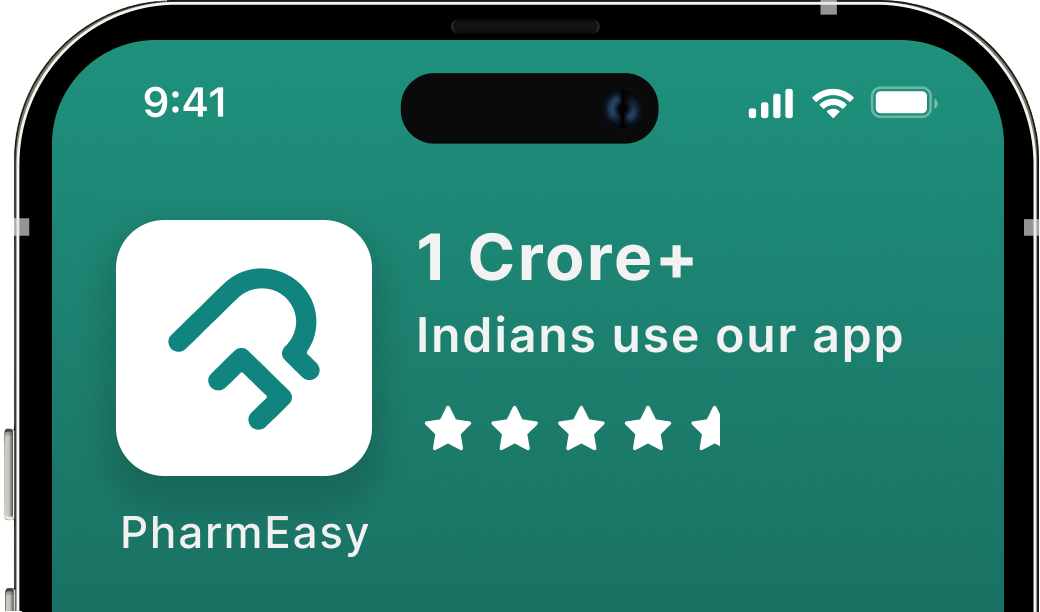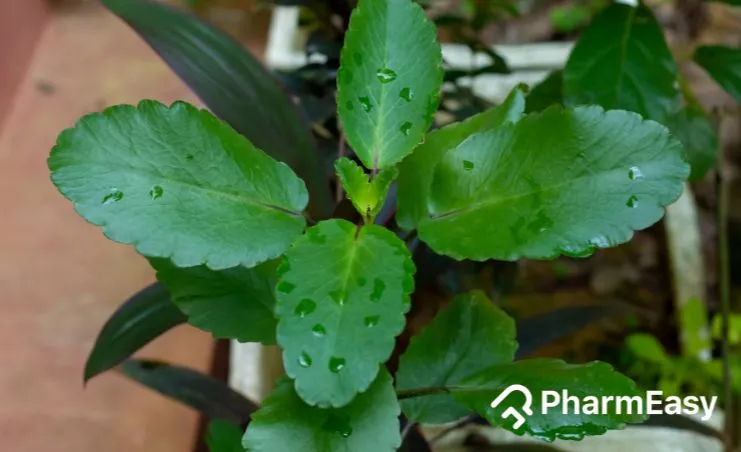Patharchatta: Uses, Benefits, Side Effects and More By Dr. Smita Barode
By Dr Smita Barode +2 more

Get,

to manage your symptom
Get your,


4 Cr+ families
benefitted

OTP sent to 9988776655



You’ve successfully subscribed to receive
doctor-approved tips on
Whatsapp

Get ready to feel your best.

Hi There,
Download the PharmEasy App now!!


Register to Avail the Offer
Send OTPBy continuing, you agree with our Privacy Policy and Terms and Conditions

Hi There,
Sign up on PharmEasy now!!
Trusted by 4 crore+ families

OTP sent to 9988776655



You have unlocked 25% off on medicines




Code: NU25
By Dr Smita Barode +2 more
Table of Contents
Patharchatta, also known as kalanchoe, is a plant widely grown in India. It is commonly known as an ‘air plant,’ as it has tall hollow stems. Kalanchoe has bell-like pendulous flowers and dark fleshy green leaves. Patharchatta is grown in temperate regions of Asia, the West Indies, Australia, New Zealand, etc. The scientific name of the plant is Bryophyllum pinnatum, and it belongs to the family Crassulaceae. Patharchatta is a medicinal plant known to be a host of therapeutic nutrients1,2. Let us look at some of the health benefits of patharchatta.

Patharchatta may be rich in bioactive compounds like alkaloids, flavonoids, glycosides, triterpenes, cardienolides, bufadienolides, lipids, and steroids. Here are the nutritional components of Patharchatta along with their values3.
Several studies have shown that patharchatta may have the following properties4:
Some of the potential uses of patharchatta are:
A study5 by Matthew et al. in 2013 on albino rats showed that patharchatta might have anti-inflammatory and analgesic activity. The result suggested that the stem extract of patharchatta may reduce pain and inflammation. However, further studies are required to check if patharchatta may be useful in relieving pain and inflammation. Therefore, you must consult a doctor if you suspect inflammation or experience pain for a prolonged period.
A study6 by Phatak et al. in 2015 showed that patharchatta might be used to help remove kidney stones from the body. Kidney stones are made of calcium oxalate crystals. Saponins in the patharchatta plant may dissolve the calcium oxalate crystals. However, further large-scale studies are yet to be done to check if patharchatta can be beneficial in the case of kidney stones. Therefore, you must immediately consult your doctor if you suspect a kidney stone.
A study7 by Patil et al. in 2013 showed that patharchatta might be used in the case of diabetes mellitus. A bioactive compound, such as the derivative of phenyl alkyl ether in patharchatta, may stimulate insulin secretion, further decreasing blood sugar levels. However, further studies are required to check if patharchatta can reduce blood sugar levels. Therefore, you must check your blood sugar levels regularly and consult your doctor in case of abnormal blood sugar levels.
A study8 by Tajudin et al. in 2022 showed that patharchatta might have anti-microbial properties. The phenolic compounds in patharchatta may disrupt the bacterial wall and reduce the toxic substances secreted by the bacteria. Patharchatta may be beneficial for typhoid and respiratory tract infections caused by bacteria. However, further studies are required to check if patharchatta may be beneficial for infections caused by microorganisms. Therefore, you must consult your doctor if you suspect a microbial infection.
One of the reasons for stomach ulcers is excess acid secretion. Inflammatory cytokines are molecules that cause inflammation at the site of ulcers. A study9 by Araújo in 2018 showed that patharchatta might be used for stomach ulcers. Flavonoids in patharchatta may reduce inflammation at the site of ulcers by inhibiting the release of inflammatory cytokines and reducing excess acid secretion. However, further studies on humans are required to check if patharchatta may be beneficial for stomach ulcers. Therefore, you must immediately consult your doctor if you suspect ulcers.
A study10 on rats showed that cardenolides and bufadienolides in patharchatta may possess wound-healing activity. The result suggested that patharchatta may reduce redness at the site of the wound. However, further studies are needed to check if patharchatta may be used to heal wounds. Therefore, you must immediately consult your doctor if your wound does not heal for a prolonged period.
Leishmaniasis is an infection caused by the Leishmania parasite. A study11 showed that bioactive compounds like coumarin and quercetin in patharchatta may be useful for Leishmaniasis. Patharchatta may activate reactive nitrogen species in white blood cells, which are important to control the Leishmania in these cells. However, further studies are required to check if patharchatta can be used for Leishmaniasis. You must consult your doctor if you suspect a Leishmaniasis infection.
A study1 by Supertman et al. in 2001 showed that patharchatta might possess anticancer activity due to bioactive compounds like bufadienolides. Another study9 by Ueda et al. in 2022 showed that patharchatta extracts may inhibit the growth of cancerous cells. However, further studies are required to check if patharchatta may be beneficial for cancer. Therefore, you must immediately consult a doctor if you suspect cancer instead of self-medicating.
Though studies show the benefits of patharchatta in various conditions, these are insufficient, and there is a need for further studies to establish the true extent of the benefits of patharchatta on human health.
Patharchatta can be consumed in the following way:
You must consult a qualified doctor before taking patharchatta in large quantities or any herbal supplements. Do not discontinue or replace an ongoing treatment of medicine with an ayurvedic/herbal preparation of patharchatta without consulting a qualified doctor.
Patharchatta is generally considered to be safe. However, a small-scale study on 20 cancer patients has reported the following side effects in animals12:
If any reaction is noticed on using patharchatta, seek immediate medical attention. Consult your ayurvedic physician who has prescribed it to you; they will be able to identify the cause and treat it effectively.
Also Read: Ber Fruit (Jujube): Uses, Benefits, Side Effects & More!
The following precautions can be taken before consuming patharchatta:
Precautions should be taken before giving patharchatta to the elderly or children. You must consult your doctor before you consume patharchatta if you have any pre-existing diseases.
Also Read: Cashew Nuts: Uses, Benefits, Side Effects & More
There is not enough evidence on the interaction of patharchatta with other drugs. Further studies on the interaction of patharchatta are required. Therefore, you must consult your doctor if you are on any other medication before consuming patharchatta.
As with any other general medicine, general precautions should be taken while having patharchatta. Pregnant women and lactating mothers should take special care. You must consult your doctor before having a patharchatta. Precautions should be taken before giving patharchatta to the elderly or children. In such cases, you must have patharchatta only if your doctor prescribes it.
There is not enough evidence on the interaction of patharchatta with other medicines. Further studies on the interaction of patharchatta are required. Therefore, you must consult your doctor if you are on any other medication before consuming patharchatta.
Disclaimer: The information provided here is for educational/awareness purposes only and is not intended to be a substitute for medical treatment by a healthcare professional and should not be relied upon to diagnose or treat any medical condition. The reader should consult a registered medical practitioner to determine the appropriateness of the information and before consuming any medication. PharmEasy does not provide any guarantee or warranty (express or implied) regarding the accuracy, adequacy, completeness, legality, reliability or usefulness of the information; and disclaims any liability arising thereof.
Comments

Leave your comment...
You may also like
Comments